

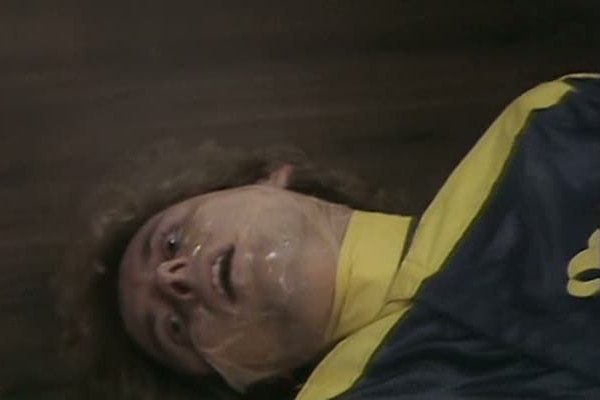
One of the most-repeated stories on nostalgia shows, where parasitic aliens disguising themselves as shell suits in a bid to enslave mankind is milked for mockery. With such subject matter, then not everyone treats it with a sombre mood, in particular Ralph Lawford, hamming it up as a wide-eyed shopkeeper, and Mike Holoway clearly isn't taking any of it seriously, ending the story by patting a co-star on the head with a snotty tissue.
On a personal note, when I first saw this story I was drunk, and it seemed far more compelling and eerie than it does sober – even what is known today as a "camel toe" on Elizabeth (episode two) felt in keeping with the tone. So while The Anorak Zone would never advocate alcohol abuse, it notes that season seven makes a Hell of a lot more sense under the influence. Drunk, this came twelfth in this ranking… watched again sober, it tumbles a couple of places.
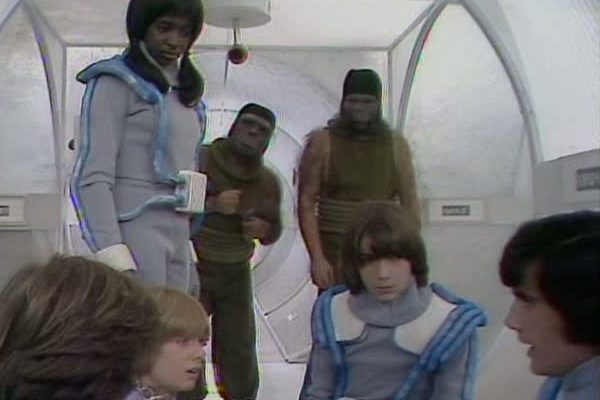
The middle story of season two, The Tomorrow People's finest hour. This is the weakest link, hence the placing, and does get more trite as it goes on, but is still quite diverting. A tale of shared dreams, time travel and the Roman empire, it has a certain scope, though doesn't really contain much that seems fresh or resonant today.

As can be gleaned from the picture above, parts of this story could be regarded as very silly – it is, after all, a story about aliens who dress up as pinstripe businessmen while their ship pilot is a humanoid dog played by the guy behind Bungle off Rainbow. However, this one rackets along with invention, and drips with light wit. What should be silly and grating works, because almost all of it is consistent within its own universe. The tone is even throughout, and even though the ending is a little anti-climactic, this is one that also rewards by placing the leads in a situation they almost can't get out of.
Of the eleven directors that worked on The Tomorrow People, incidentally, then almost none of them were, with respect, that notable in the field. Resumes included the blander Jon Pertwee Doctor Who adventures, Button Moon, T-Bag's Christmas Carol and The Sooty Show. Perhaps the second most-noted is Vic Hughes, the most prolific director on the show, who went on to helm the series Chocky. However, the director of Achilles Heel had far wider success: Gabrielle Beaumont, the show's only female director, later worked on M*A*S*H, Dynasty, Hill Street Blues, three separate series of Star Trek, Miami Vice, The Waltons, The Dukes of Hazzard and many more.
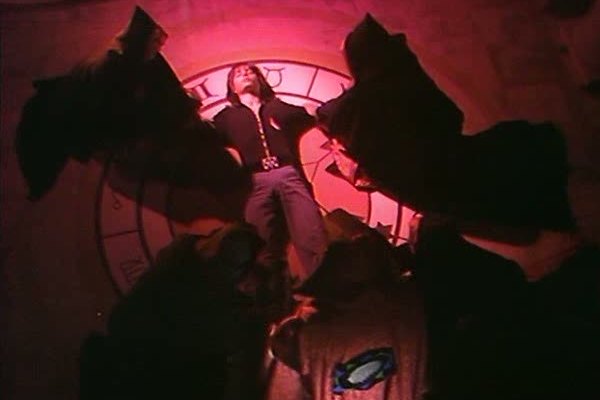
The story most famous for featuring Mike Holoway's band Flintlock, here playing his character's band "The Fresh Hearts". In real life, they were a group that only had marginal commercial success, just one of their nine singles - the okayish Dawn - hitting the top 30. However, while their many children's show and Look-In appearances didn't translate to chart appeal, it did build them enough of a cache amongst the target group that Mike was able to slip over into The Tomorrow People and become a focal point of the series. In the fiction of the story they're about to be broadcast live to millions... only unfortunately the band are playing mind-controlling voodoo rhythms from an old African drum. It's borderline offensive, hackneyed nonsense, and the character of John ("I always thought one enjoyed music for its melody, not for its volume!") has never seem more outdated.
In many ways it's a reflection of a series that has been hijacked by behind-the-scenes negotiations rather than genuine creative vision... even the once-enigmatic opening titles now see Holoway get the series' first and only smiley face. All of which makes The Heart of Sogguth sound terrible... yet, like Hitler's Last Secret, it's also one of the most watchable tales they ever did. On one last note of trivia, then The Tomorrow People was a successful series, sold abroad to more than 50 countries, and did not go without merchandising. Many years later Big Finish would release 22 audio stories (2001-2006) and, during the first five seasons, the programme had its own comic strip in Look In magazine. This is particularly notable for a 1974 story amongst its 34 tales... a group called Starway use music to hypnotise the population. With the strip written by Angus P. Allan, it's not known if the concept was an influence on Price, unconsciously or not.
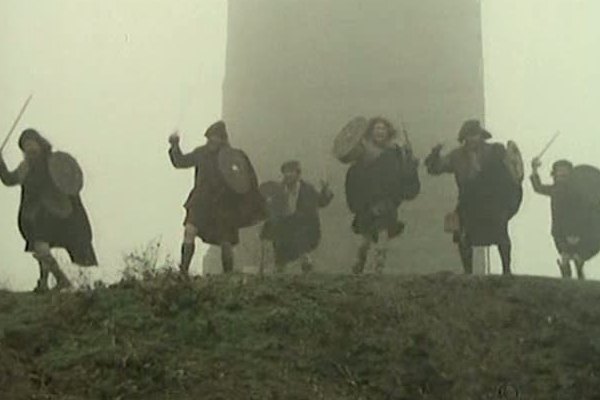
Castle of Fear continues a tradition of introducing a new Tomorrow Person into the series with each season's opening story. A clever dramatic ploy that enables the basic concept to be retold to any new viewers, it nevertheless means in this instance that things are beginning to get crowded. Misako Koba was introduced as Hsui Tai in the previous season, largely due to Elizabeth Adare being away on pregnancy leave. Adare returns here and for the remainder of the programme, meaning that there are four established Tomorrow People already in the show. And although 13-year-old Nigel Rhodes isn't terrible by the overall relative standards of the leads, he's unable to make much of an impression when he becomes a fifth cast member as Andrew Forbes. Having to split the plots over all five characters, particularly when the series had become so focussed on Mike, doesn't always work to its best advantage. Although The Tomorrow People was about teenagers all over the world "breaking out", simple dynamics of television meant that such a series didn't have the time or resources to do justice to all the characters fairly. As for Castle of Fear itself, then it's slight yet warmly likeable... hence its inclusion in the top ten.
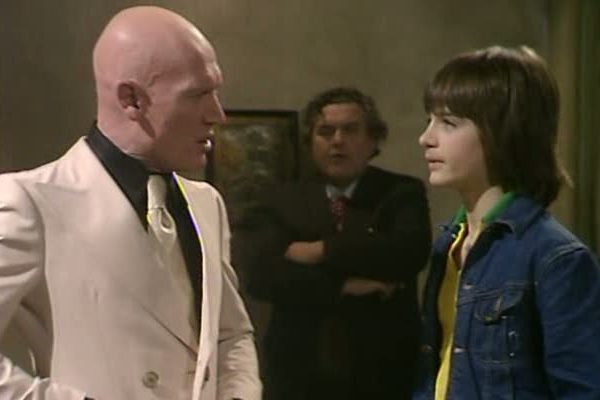
One Law introduced Mike Holoway as new Tomorrow Person Mike Bell, and in so doing put the writing on the wall for original lead Stephen (Peter Vaughan-Clarke) and, less crucially, later co-star Tyso. Like a lot of the regulars, his acting isn't perhaps up to pure professional standards (Vaughan-Clarke, while conceding they got on, observed that "He couldn't act at that time I don't think [...] he was pretty poor show") but he gets by on charisma. When the series began Vaughan-Clarke was the youthful 15-year-old there as a central identification figure for the teen audience, and Nicholas Young was the more sensible, authoritarian figure there to keep the plots moving. As Vaughan-Clarke was now 18 there were suddenly two "elder brother" figures in the cast, and Holoway was the new fresh-faced 15-year-old, leaving Stephen with nowhere to go.
As for One Law as a story, then it's symptomatic of the way the series could pull in different directions, doubtless in part because it was, after all, a children's programme. But a story that takes place in working class London tower blocks where gangsters threaten to strangle an old man's cat until he fearfully exploits Mike is one that's rich in potential and could have been a dark, gritty entry. Sadly, the gangsters are cartoon characters and elements such as Tim Barrett doing a "turn" as a comedy policeman jar badly with the sight of Patrick McAlinney playing it straight as the old man who is later beaten up and left in bruises. Tracing the path of Mike, the rest of the Tomorrow People flit from scene to scene, reassuring the elderly victim of violent assault one minute and then double-taking at a jokey copper the next. The two wildly different representations of reality struggle, and fail, to work together as a convincing whole. Let's not even talk about the uses of a "waaaa waaaaaaaa" Carry On-style sound effect. It's watchable television, but should have been much, much better.

The opening story of the series, this five-parter is fast-paced for the time and details the set-up of the series with some charm. The idea that "breaking out" could be a euphemism for puberty, sexuality or just plain being different is a compelling one. The idea of the group being menaced by two comedy bikers and the sheer ineptness of Stephen Salmon's "acting" are things to fear, but for all the silliness, pulp SF and childishly cheap robot costumes, this one does have a special something. What that "something" is, is anyone's guess, but you can see the potential for a great series here, albeit trapped beneath layers of child-friendly silliness.